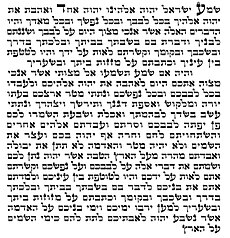Mezuzah
 The parchment of the mezuzah | |
| Halakhic texts relating to this article | |
|---|---|
| Torah: | Deuteronomy 6:9 and Deuteronomy 11:21 |
| Mishnah: | Menachot 3:7 |
| Babylonian Talmud: | Shabbat 32a, Yoma 11a, Menachot 33a, |
| Mishneh Torah: | Tefillin, Mezuzah, veSefer Torah ch 5-6 |
| Shulchan Aruch: | Yoreh De'ah 285-291 |
A mezuzah (Template:Lang-he "doorpost") (plural: mezuzot (מזוזות)) is a piece of parchment (usually contained in a decorative case) inscribed with specified Hebrew verses from the Torah (Deuteronomy 6:4–9 and 11:13–21). These verses comprise the Jewish prayer "Shema Yisrael," and begins with the phrase "Hear, O Israel, the Lord your God, the Lord is One."
A mezuzah is affixed to the doorframe of Jewish homes to fulfill the mitzvah (Biblical commandment) to inscribe the words of the Shema "on the doorposts of your house."(Deuteronomy 6:9) Many families place a mezuzah on the front door only, but observant Jews fix one on every doorway in the home apart from bathrooms, and closets too small to qualify as rooms.[1] The parchment is prepared by a qualified scribe (a "sofer stam") who has undergone many years of meticulous training, and the verses are written in indelible black ink with a special quill pen. The parchment is then rolled up and placed inside the case.
Affixing the mezuzah
According to halakha, the mezuzah should be placed on the right side of the door, in the upper third of the doorpost (i.e., approximately shoulder height),[2] within approximately 3 inches of the doorway opening. Generally, halakha requires that mezuzot be affixed within 30 days of moving into a rented house or apartment. This applies to Jews living in the Diaspora (i.e. outside the Land of Israel). For a purchased home or apartment in the Diaspora, or a residence in Israel (owned or rented), the mezuzah is affixed immediately upon moving in. The case can be affixed to the doorpost with nails, screws, glue, or double-sided tape. Wrapping the scroll in plastic wrap before placing it in the case will protect it from the elements. Care should be taken to not tear or damage the parchment or the wording on it, as this will invalidate the mezuzah.
Where the doorway is wide enough, Ashkenazi Jews and Spanish and Portuguese Jews tilt the mezuzah so that the top slants toward the room into which the door opens. This is done to accommodate the variant opinions of the medieval Rabbis Rashi and Rabbeinu Tam as to whether it should be placed horizontally or vertically, and also to imply that God and the Torah (which the mezuzah symbolizes) are entering the room. Most Sephardim and other non-Ashkenazi Jews affix the mezuzah vertically.[3]
The procedure is to hold the mezuzah against the spot upon which it will be affixed, then recite a blessing:
- .Template:Hebrew
- Baruch atta Adonai Eloheinu melech ha‘olam, asher kideshanu bemitzvotav vetzivanu likboa‘ mezuza.
- Blessed are You, Lord our God, King of the Universe, Who sanctified us with His mitzvot, and commanded us to affix a mezuzah.
Any Jew can recite the blessing provided he or she is old enough to understand the significance of the mitzvah. After the blessing, the mezuzah is attached.
When affixing several mezuzot, it is sufficient to recite the blessing once, before affixing the first one. Video: Affix Mezuzah How-To
Checking the parchment
Orthodox Jews have a qualified scribe check the mezuzot parchments for defects (such as small tears or faded lettering) at least twice every seven years.[4][5]
Mezuzah cases

The commandment to affix a mezuzah is widely followed in the Jewish world, even by Jews who are not religiously observant. While the important part of the mezuzah is the "klaf," or parchment, and not the case itself, designing and producing mezuzah cases has been elevated to an art form over the ages. Mezuzahs are produced from an endless variety of materials, from silver and precious metals, to wood, stone, ceramics and pewter. In fact, the beauty of many of these cases has led some to forget that the important part of the mezuzah is the parchment. Some dealers of mezuzah cases will provide or offer for sale a copy of the text that has been photocopied onto paper; this is not a valid mezuzah, which must be handwritten onto a piece of parchment by a qualified scribe.
Inscriptions
It is customary to write two inscriptions on the back of the parchment: the Hebrew word שדי (Shaddai), and the phrase "כוזו במוכסז כוזו".
Shaddai, one of the biblical names of God, also serves here as an acronym for "Shomer Delatot Yisrael" ("guardian of the doorways of Israel"). Many mezuzah cases are also marked with the Hebrew letter ש (Shin), for "Shaddai".
"כוזו במוכסז כוזו" is a Caesar cipher — a one letter shift — of the third, fourth, and fifth words of the Shema, "Adonai, Eloheinu, Adonai", "The Lord, our God, the Lord"; it is written on the back of the mezuzah, opposite the corresponding words on the front.[6] This inscription, Kabbalistic in origin, has appeared on mezuzot since at least the 11th century.[7]
References
- ^ Dovid Zaklikowski. "Which Rooms Require a Mezuzah?".
- ^ Beit Yosef YD 289; and see Nekudot Hakesef ad loc
- ^ Rabbi Carl M. Perkins. "How Should a Mezuzah be Oriented?".
- ^ Babylonian Talmud, Yoma 11a
- ^ Shulchan Aruch (291:1)
- ^ Alexander Poltorak The Mysterious Name
- ^ Eliyahu Yaniger. "MezuzahNet: Ask the Sofer". Baal Shem Tov Foundation, 2003.
{{cite web}}: Unknown parameter|accessmonthday=ignored (help); Unknown parameter|accessyear=ignored (|access-date=suggested) (help)
Further reading
- Alexander Poltorak. A Light unto My Path: A Mezuzah Anthology.
- Dovid Zaklikowski. Mezuzah Handbook.
- "Internet Encyclopaedia of Religion".
- Mezuzah Blog - Much information about Mezuzahs as well as Mezuzahs in the news


